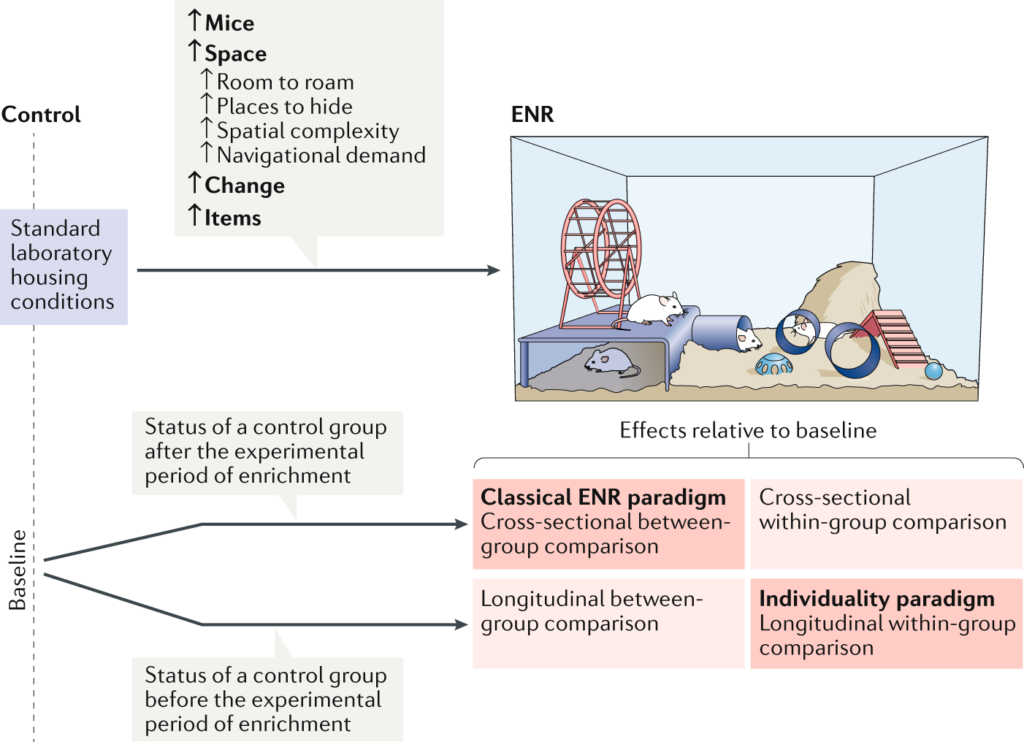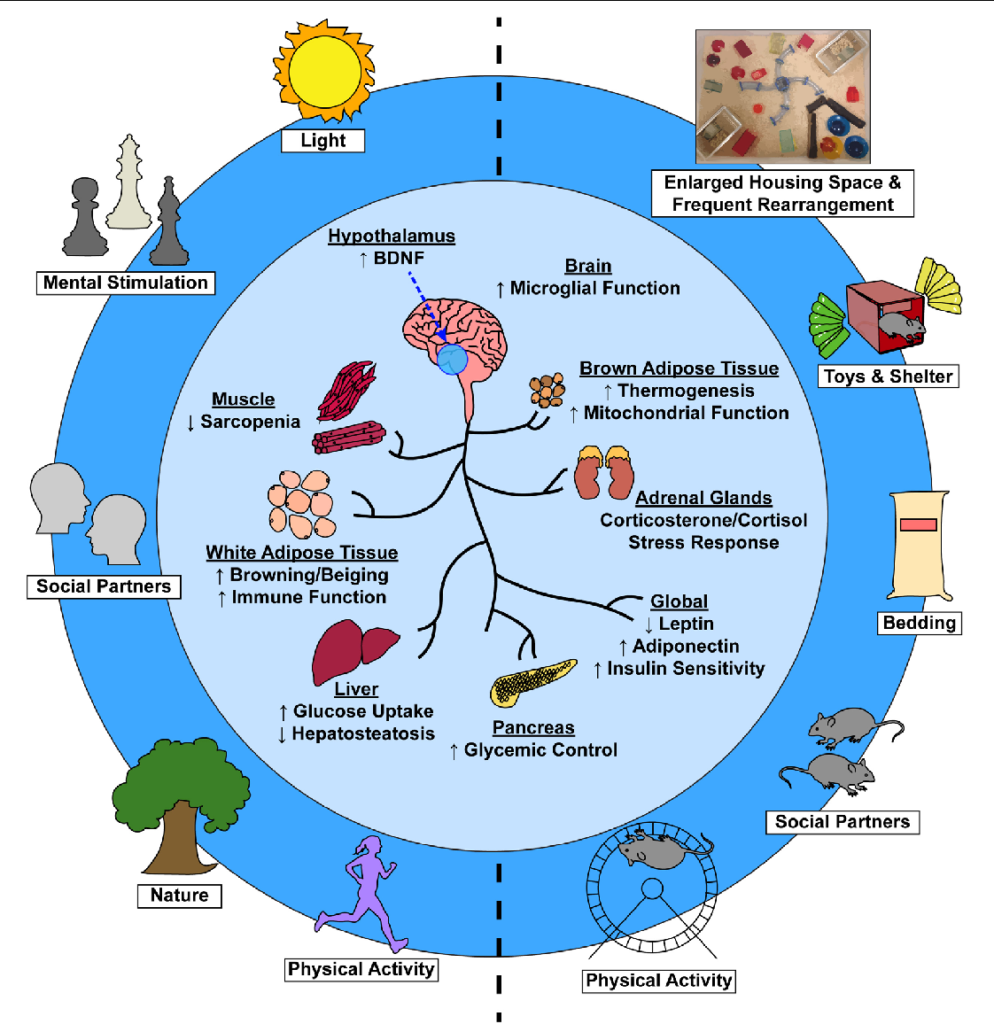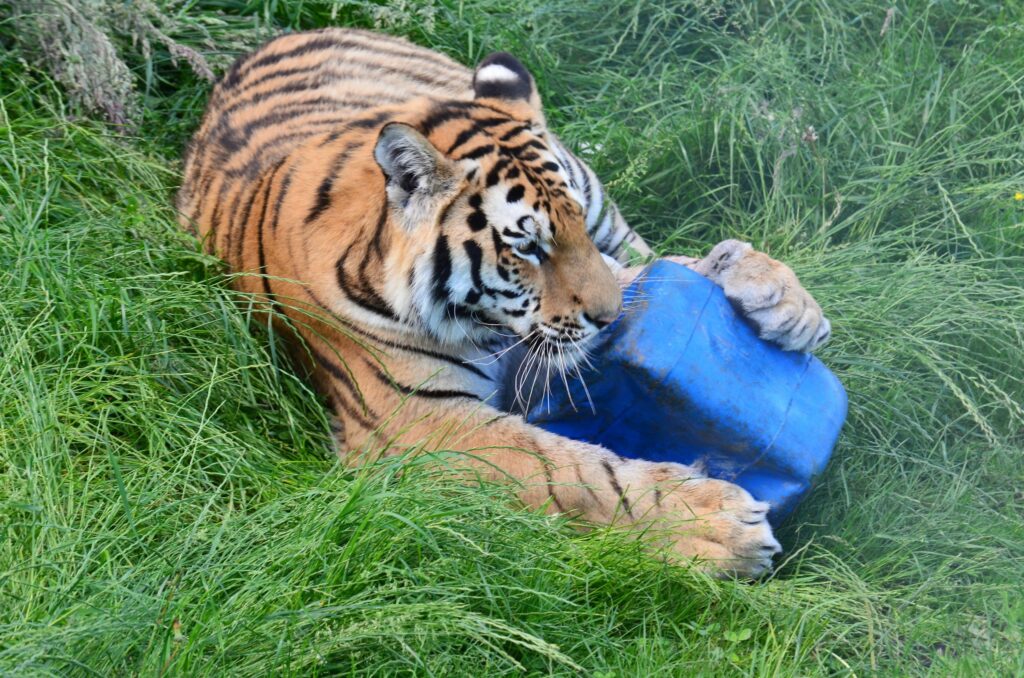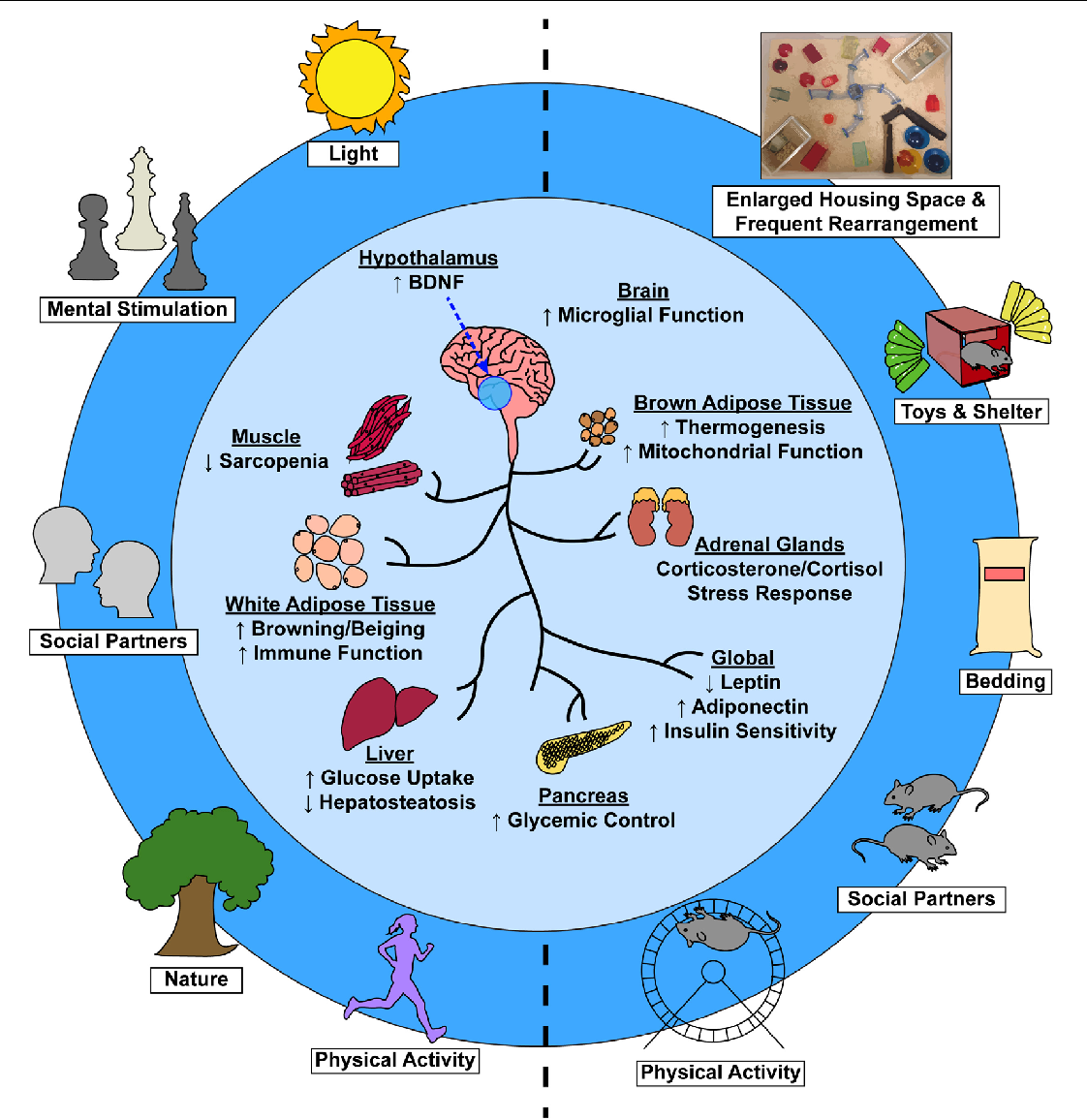Have you ever wondered how the environment can impact the well-being of animals? In this article, we explore the fascinating topic of environmental enrichment and its role in reducing stress and promoting natural behaviors. By understanding how providing suitable physical and social stimulation can improve an animal’s quality of life, we delve into the importance of creating enriched environments for our furry friends. Join us as we explore the powerful effects of environmental enrichment on stress reduction and the promotion of natural behaviors in animals.
Introducing Environmental Enrichment
Understanding the concept of environmental enrichment
Environmental enrichment refers to the practice of enhancing the living environment of animals by providing them with stimuli and activities that promote natural behaviors, mental stimulation, and overall well-being. It is based on the understanding that animals, just like humans, require a stimulating and enriching environment to thrive.
The importance of providing a stimulating environment for animals
Animals, whether they are domesticated pets, captive wildlife, farm animals, or laboratory animals, benefit greatly from a stimulating environment. Providing them with an environment that meets their physical, social, cognitive, and sensory needs can have a significant positive impact on their mental and physical health. Environmental enrichment can help reduce stress and anxiety, promote natural behaviors and instincts, and improve overall animal welfare.
Benefits of Environmental Enrichment
Reducing stress and anxiety in animals
One of the key benefits of environmental enrichment is its ability to reduce stress and anxiety in animals. Just like humans, animals experience emotions and can become stressed or anxious when they are deprived of stimulation and mental engagement. Providing them with a variety of enrichment activities and stimuli can help alleviate these negative emotions and create a sense of calm and well-being. This is particularly important in captivity, where animals may be confined in small or artificial environments.
Promoting natural behaviors and instincts
Environmental enrichment also plays a crucial role in promoting natural behaviors and instincts in animals. When animals are provided with opportunities to engage in activities that mimic their natural behaviors, such as foraging, nesting, exploring, and socializing, they are more likely to exhibit natural behaviors and lead fulfilling lives. This is particularly important in captive settings, where animals may be deprived of these opportunities.
Improving overall animal welfare and health
By reducing stress, promoting natural behaviors, and providing mental stimulation, environmental enrichment contributes to overall animal welfare and health. When animals are mentally and physically stimulated, they are less likely to develop behavioral issues, such as aggression or stereotypic behaviors. Additionally, a stimulating environment can also improve cognitive function and prevent boredom, leading to better overall health for the animals.

Types of Environmental Enrichment
Physical enrichment
Physical enrichment involves providing animals with objects or structures that encourage physical activity and play. This can include items such as toys, climbing structures, tunnels, or platforms that allow animals to engage in natural behaviors like running, jumping, climbing, and exploring. Physical enrichment not only provides exercise opportunities but also helps to keep animals physically fit and prevents boredom.
Social enrichment
Social enrichment focuses on providing animals with opportunities to interact with conspecifics or, in the case of domesticated pets, with their human caregivers. Social interaction is crucial for animals that are naturally social or live in social groups, as it fulfills their social needs and promotes healthy social behaviors. Social enrichment can include opportunities for play, group housing, or even training sessions with humans.
Cognitive enrichment
Cognitive enrichment involves providing animals with mental challenges and problem-solving opportunities. This can include puzzles, food-dispensing toys, or training sessions that require animals to use their cognitive skills to obtain rewards. Cognitive enrichment not only keeps animals mentally engaged but also helps to prevent boredom, reduce stress, and improve cognitive function.
Sensory enrichment
Sensory enrichment focuses on stimulating the senses of animals by providing them with a variety of sensory experiences. This can include exposure to different sounds, smells, textures, or visual stimuli that mimic their natural environment. Sensory enrichment helps to keep animals mentally stimulated and engaged, promote exploration and curiosity, and prevent sensory deprivation.
Implementing Environmental Enrichment
Assessing the specific needs and preferences of the animals
Before implementing environmental enrichment programs, it is essential to assess the specific needs, preferences, and behaviors of the animals in question. Different species and individuals within those species may have different needs and preferences. For example, some animals may be more active and require more physical stimulation, while others may be more social and benefit from increased social interactions. Understanding the specific needs of the animals is crucial when designing enrichment programs.
Designing and setting up enrichment programs
Once the specific needs and preferences of the animals have been assessed, enrichment programs can be designed and implemented. This involves selecting appropriate enrichment techniques and activities based on the identified needs of the animals. For physical enrichment, providing climbing structures, toys, or objects that encourage natural behaviors can be beneficial. Social enrichment may involve introducing compatible conspecifics or organizing structured play sessions. Cognitive enrichment can be achieved through training sessions or providing food puzzles. Sensory enrichment can be achieved through the introduction of different scents, sounds, or textures. Setting up appropriate enrichment tools and ensuring their accessibility to the animals is also important.
Monitoring and evaluating the effectiveness of enrichment initiatives
It is crucial to monitor and evaluate the effectiveness of environmental enrichment initiatives to ensure they are benefitting the animals as intended. This can be done through behavioral observations, physiological measurements, or surveys. By closely monitoring how animals interact with the enrichment tools and how their behavior changes over time, adjustments can be made to optimize the effectiveness of the enrichment programs.

Environmental Enrichment for Different Animal Species
Enrichment strategies for captive primates
Captive primates, such as monkeys and apes, benefit greatly from environmental enrichment. They are highly intelligent, social animals who thrive in environments that provide opportunities for mental and physical stimulation. Enrichment strategies for captive primates can include providing puzzle toys and food enrichment, offering opportunities for social interactions, creating climbing structures, and stimulating their senses through visual and auditory stimuli.
Enrichment techniques for domesticated pets
Domesticated pets, such as dogs and cats, also require environmental enrichment to lead fulfilling lives. For dogs, enrichment can involve interactive toys, training sessions, and daily exercise routines. Providing separate areas for resting, eating, and playing can help create a stimulating environment for cats. Additionally, opportunities for hunting-related activities, such as puzzle feeders or interactive toys, can be beneficial.
Enrichment considerations for farm animals
Farm animals, despite their intended purpose for production, also benefit from environmental enrichment. Enrichment strategies for farm animals can include providing them with access to outdoor spaces, allowing for natural behaviors like foraging or grazing, and engaging them in social interactions. For example, providing pigs with straw or mud pools, allowing chickens to roam and peck, or offering environmental enrichment devices for cows can improve their overall welfare.
Environmental Enrichment for Laboratory Animals
Importance of providing mental stimulation for research animals
Laboratory animals, often used in research settings, are particularly susceptible to stress and boredom due to their confined environments. It is essential to provide them with environmental enrichment to ensure their mental well-being, improve research outcomes, and enhance the reliability of scientific studies. Enrichment can help prevent the development of abnormal behaviors and reduce stress-related physiological responses, ultimately leading to more accurate research results.
Enrichment practices in laboratory settings
Enrichment practices for laboratory animals can include providing appropriate housing and bedding materials, introducing environmental enrichment devices, offering opportunities for physical activity and social interactions, and implementing training programs that stimulate cognitive abilities. For example, providing mice with tunnels, hiding places, or nesting material allows them to engage in natural behaviors and reduces stress.
Ethical implications and guidelines for animal research
The implementation of environmental enrichment in laboratory settings raises ethical considerations and has led to the development of guidelines to ensure the welfare of research animals. These guidelines often emphasize the importance of providing enrichment, taking into account the species-specific needs and preferences of the animals, and conducting regular assessments of their well-being. Ethical considerations aim to strike a balance between scientific research and the welfare of the animals involved.

Challenges and Limitations of Environmental Enrichment
Financial constraints and resource limitations
Implementing environmental enrichment programs can be challenging due to financial constraints and resource limitations. Providing appropriate enrichment tools and activities can be costly, especially for larger and more complex species. Additionally, ensuring that the necessary resources, such as space, materials, and personnel, are available to design and maintain enrichment programs can be a significant challenge.
Overcoming potential risks and safety concerns
Another challenge of environmental enrichment is ensuring the safety of the animals and those involved in their care. Enrichment tools and activities must be carefully selected and monitored to prevent injuries or negative interactions. Additionally, certain animals may have specific sensitivities or health conditions that need to be taken into consideration when designing enrichment programs.
Educating and training animal caretakers on enrichment techniques
Proper education and training of animal caretakers are essential for the successful implementation of environmental enrichment initiatives. Caretakers need to understand the importance of enrichment, be familiar with different techniques and tools, and possess the necessary skills to monitor and assess the effectiveness of enrichment programs. Providing ongoing education and training opportunities can help overcome this challenge and ensure the well-being of the animals.
Case Studies: Successful Enrichment Programs
Zoos and wildlife conservation organizations
Zoos and wildlife conservation organizations have been at the forefront of implementing successful environmental enrichment programs. These institutions recognize the importance of providing a stimulating environment for captive animals and have developed innovative strategies to meet the specific needs of different species. For example, many zoos provide climbing structures, pools, or artificial prey items to encourage natural behaviors and improve the well-being of the animals in their care.
Animal shelters and rescue centers
Animal shelters and rescue centers often work with animals that have experienced trauma or neglect. Environmental enrichment plays a crucial role in helping these animals recover and find new homes. Enrichment techniques used in shelters can include providing toys, offering socialization opportunities, and using positive reinforcement training methods. These strategies help reduce stress and anxiety and prepare animals for their transition into permanent homes.
Case studies showcasing the positive impact of environmental enrichment initiatives
Numerous case studies have demonstrated the positive impact of environmental enrichment initiatives on the well-being of animals. For example, studies conducted on primates in captivity have shown that providing them with opportunities for mental and physical stimulation reduces aggression, stereotypic behaviors, and self-injury. Similarly, research on laboratory animals has shown that enrichment improves their overall welfare and contributes to more reliable research outcomes.

Future Perspectives and Research
Advancements in environmental enrichment techniques and designs
As our understanding of animal behavior and welfare continues to evolve, advancements in environmental enrichment techniques and designs are expected. The development of innovative tools and activities, based on the specific needs of different species, will allow for more effective and engaging enrichment programs. Additionally, technological advancements may provide new opportunities for interactive and automated enrichment, further enhancing the well-being of animals in various settings.
The role of technology in enhancing animal welfare
Technology has the potential to play a significant role in enhancing animal welfare through environmental enrichment. Virtual reality and augmented reality technologies could be utilized to provide animals with virtual environments that mimic their natural habitats or allow for interactive experiences. Automated enrichment devices or smart systems could also be developed to provide animals with stimuli and activities tailored to their individual needs.
Promising directions for further research and collaboration
Further research in the field of environmental enrichment is essential to continuously improve animal welfare and well-being. Promising directions for research include investigating the long-term effects of enrichment on animal behavior and health, developing strategies to effectively measure and assess the impact of enrichment programs, and exploring the benefits of cross-species and interdisciplinary collaborations in enrichment research.
Conclusion
Environmental enrichment is a crucial component of ensuring the well-being of animals in various settings. By providing animals with stimulating and engaging environments, we can reduce stress and anxiety, promote natural behaviors and instincts, and improve their overall welfare and health. From physical and social enrichment to cognitive and sensory enrichment, there are various strategies and techniques that can be implemented to meet the specific needs of different species. While there may be challenges and limitations in implementing environmental enrichment programs, the positive impacts that these initiatives have on animal welfare make them well worth the effort. Through ongoing research, collaboration, and innovation, we can continue to enhance the lives of animals and create a more enriching and fulfilling existence for them.

